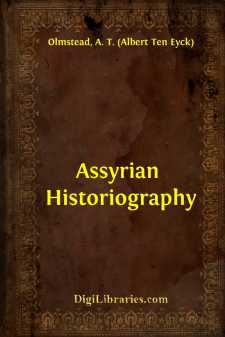Categories
- Antiques & Collectibles 13
- Architecture 36
- Art 48
- Bibles 22
- Biography & Autobiography 813
- Body, Mind & Spirit 142
- Business & Economics 28
- Children's Books 15
- Children's Fiction 12
- Computers 4
- Cooking 94
- Crafts & Hobbies 4
- Drama 346
- Education 46
- Family & Relationships 57
- Fiction 11829
- Games 19
- Gardening 17
- Health & Fitness 34
- History 1377
- House & Home 1
- Humor 147
- Juvenile Fiction 1873
- Juvenile Nonfiction 202
- Language Arts & Disciplines 88
- Law 16
- Literary Collections 686
- Literary Criticism 179
- Mathematics 13
- Medical 41
- Music 40
- Nature 179
- Non-Classifiable 1768
- Performing Arts 7
- Periodicals 1453
- Philosophy 64
- Photography 2
- Poetry 896
- Political Science 203
- Psychology 42
- Reference 154
- Religion 513
- Science 126
- Self-Help 84
- Social Science 81
- Sports & Recreation 34
- Study Aids 3
- Technology & Engineering 59
- Transportation 23
- Travel 463
- True Crime 29
Assyrian Historiography
Description:
Excerpt
CHAPTER I
ASSYRIAN HISTORIANS AND THEIR HISTORIES
To the serious student of Assyrian history, it is obvious that we cannot write that history until we have adequately discussed the sources. We must learn what these are, in other words, we must begin with a bibliography of the various documents. Then we must divide them into their various classes, for different classes of inscriptions are of varying degrees of accuracy. Finally, we must study in detail for each reign the sources, discover which of the various documents or groups of documents are the most nearly contemporaneous with the events they narrate, and on these, and on these alone, base our history of the period.
To the less narrowly technical reader, the development of the historical sense in one of the earlier culture peoples has an interest all its own. The historical writings of the Assyrians form one of the most important branches of their literature. Indeed, it may be claimed with much truth that it is the most characteristically Assyrian of them all. [Footnote: This study is a source investigation and not a bibliography. The only royal inscriptions studied in detail are those presenting source problems. Minor inscriptions of these rulers are accorded no more space than is absolutely necessary, and rulers who have not given us strictly historical inscriptions are generally passed in silence. The bibliographical notes are condensed as much as possible and make no pretense of completeness, though they will probably be found the most complete yet printed. Every possible care has been taken to make the references accurate, but the fact that many were consulted in the libraries of Cornell University, University of Chicago, Columbia University, and the University of Pennsylvania, and are thus inaccessible at the time when the work is passing through the press, leaves some possibility of error. Dr. B. B. Charles, Instructor in Semitics in the University of Pennsylvania, has kindly verified those where error has seemed at all likely.—For the English speaking reader, practically all the inscriptions for the earlier half of the history are found in Budge-Kjing, Annals of the Kings of Assyria. 1. For the remainder, Harper, Assyrian and Babylonian Literature, is adequate, though somewhat out of date. Rogers, Cuneiform Parallels to the, Old Testament, gives an up to date translation of those passages which throw light on the Biblical writings. Other works cited are generally of interest only to specialists and the most common are cited by abbreviations which will be found at the close of the study.]
The Assyrians derived their historical writing, as they did so many other cultural elements, from the Babylonians. In that country, there had existed from the earliest times two types of historical inscriptions. The more common form developed from the desire of the kings to commemorate, not their deeds in war, but their building operations, and more especially the buildings erected in honor of the gods. Now and then we have an incidental reference to military activities, but rarely indeed do we find a document devoted primarily to the narration of warlike deeds....


